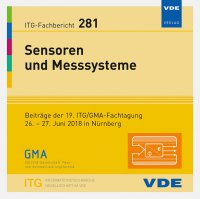Phase characteristic optimization of resonant MEMS environmental sensors
Konferenz: Sensoren und Messsysteme - 19. ITG/GMA-Fachtagung
26.06.2018 - 27.06.2018 in Nürnberg, Deutschland
Tagungsband: Sensoren und Messsysteme
Seiten: 4Sprache: EnglischTyp: PDF
Persönliche VDE-Mitglieder erhalten auf diesen Artikel 10% Rabatt
Autoren:
Setiono, Andi (Institute of Semiconductor Technology (IHT) and Laboratory for Emerging Nanometrology (LENA), Technische Universität Braunschweig, Braunschweig, Germany & Research Centre for Physics, Indonesia Institute of Sciences (LIPI), Tangerang Selatan, Indonesia)
Fahrbach, Michael; Bertke, Maik; Xu, Jiushuai; Hamdana, Gerry; Wasisto, Hutomo Suryo; Peiner, Erwin (Institute of Semiconductor Technology (IHT) and Laboratory for Emerging Nanometrology (LENA), Technische Universität Braunschweig, Braunschweig, Germany)
Inhalt:
The asymmetric resonance response in thermally-actuated piezoresistive cantilever sensors causes a need for optimization taking parasitic actuation-sensing effects into account. In this work, two compensation methods based on Wheat-stone bridge (WB) input voltage (VWB_in) adjustment and reference circuit involvement are developed and investigated to diminish these unwanted coupling influences. In the first approach, VWB_in is increased resulting in a stronger current through the WB piezoresistors as well as a temperature gradient reduction between the thermal actuator (heating resistor: HR) and the WB, which can consequently minimize the parasitic coupling. Nevertheless, increasing VWB_in (e.g., from 1 V to 3.3 V) may also yield an unwanted increased power consumption by more than 10 times. Therefore, a second compensation method is considered, where a reference electronic circuit is integrated with the cantilever sensor. Simulated and measurement results demonstrate optimized amplitude and phase characteristics in the frequency range around the resonance frequency of 190.17 kHz. With the optimized phase characteristic, frequency tracking will be easier to be implemented using a PLL system. Finally, it is expected to enhance the sensing performance of such piezore-sistive electro-thermal cantilever sensors under loading with target analytes (e.g., particulate matter, gas, and humidity).


